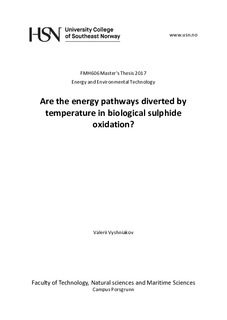Are the energy pathways diverted by temperature in biological sulphide oxidation?
Master thesis
Permanent lenke
http://hdl.handle.net/11250/2479919Utgivelsesdato
2017Metadata
Vis full innførselSamlinger
Sammendrag
Many wastewater streams contain sulphides. Their corrosiveness, toxicity and unpleasant odor makes necessary the application of removal techniques. In the present study the temperature effect (25-35 oC) and N/S ratio (<0.35) impact on biological sulphide oxidation with nitrate as an electron acceptor impact was studied. The experimental trial was conducted in expanded granular sludge bed reactor (EGSB). Nitrate and sulfur components were analyzed using ion chromatography. Additionally, the microscopy analysis was conducted for sludge samples. The almost complete removal of NO3- was achieved at all tested temperatures and ratios. Average HS-- S removal efficiency over the whole temperature study was 92% and slightly varied with temperature. Electron donor removal tended to decrease with NO3-/HS- ratio decrease from 92% (0.35) to 88% (0.245). Temperature increase caused metabolic shift manifested by increased SO42- production. The free Gibbs energy analyses were performed, however, no significant changes in overall reaction free Gibbs energy were observed. Microscopy analysis showed the possible presence of sulphur particles in sludge samples. It was suggested that high temperature (35 oC) and/or low ratios (<0.35) could be a reason of low granular sulphur accumulation.
